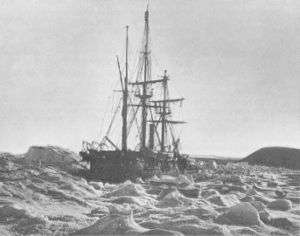British Arctic Expedition

The British Arctic Expedition of 1875-1876, led by Sir George Strong Nares, was sent by the British Admiralty to attempt to reach the North Pole via Smith Sound. Two ships, HMS Alert and HMS Discovery (captained by Henry Frederick Stephenson), sailed from Portsmouth on 29 May 1875. Although the expedition failed to reach the North Pole, the coasts of Greenland and Ellesmere Island were extensively explored and large amounts of scientific data were collected.
.jpg)
On this expedition, Nares became the first explorer to take his ships all the way north through the channel between Greenland and Ellesmere Island (now named Nares Strait in his honour) to the Lincoln Sea. Up to this time, it had been a popular theory that this route would lead to the supposed Open Polar Sea, an ice-free region surrounding the pole, but Nares found only a wasteland of ice. A sledging party under Commander Albert Hastings Markham set a new record Farthest North of 83° 20' 26"N, but overall the expedition was a near-disaster. The men suffered badly from scurvy and were hampered by inappropriate clothing and equipment. Realising that his men could not survive another winter in the ice, Nares hastily retreated southward with both his ships in the summer of 1876.
However, naval personnel and topographers, among them Thomas Mitchell, did succeed in documenting, by photograph, the Northern indigenous peoples and landscapes of what would become Canada's Northwest Territories and, later, Nunavut.
The expedition included Petty Officer Adam Ayles, after whom both the Ayles Ice Shelf and Mount Ayles are named. Other features named after the expedition include the Markham Ice Shelf, Nares Strait and Alert, Nunavut, the most northerly permanently inhabited place on earth. Pelham Aldrich was a lieutenant on the expedition and commanded the Western Sledge Party to Ellesmere Island, where Cape Aldrich was named in his honour.
Archives are held at Scott Polar Research Institute, University of Cambridge.[1]
See also
![]() Media related to British Arctic Expedition 1875 at Wikimedia Commons
Media related to British Arctic Expedition 1875 at Wikimedia Commons
Bibliography
George Nares: Narrative of a voyage to the Polar Sea during 1875-76 in H.M. ships 'Alert' and 'Discovery', two volumes, London 1878; online book Volume 1 & Volume 2
References
- John Edwards Caswell. The RGS and the British Arctic Expedition, 1875-76. The Geographical Journal 143(2) (Jul., 1977), pp. 200–210.
- Project Naming, the identification of Inuit portrayed in photographic collections at Library and Archives Canada